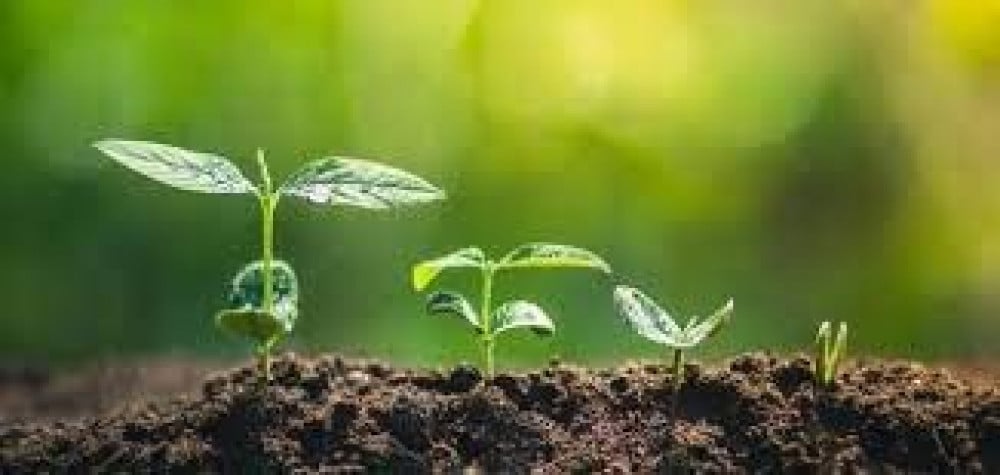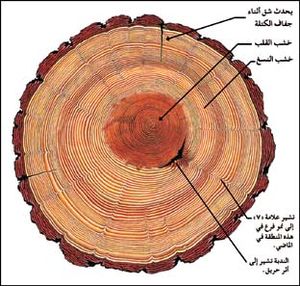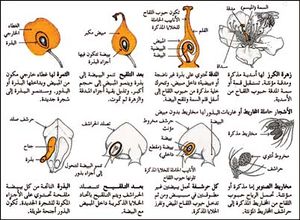How does a tree grow?
How Trees Tell Their History Most trees in temperate regions develop a layer of wood each year. After cutting the tree, these layers appear as rings in the trunk. These annual rings reveal the life history of the tree. The pine block shown in this figure has 72 annual rings, which indicates that this tree lived for 72 years. The narrow rings in the center indicate that other trees had shaded this young tree, depriving it of moisture and sunlight. The wide rings on the lower side of this block after the thirtieth year indicate that the tree was slightly tilted in this direction. The tree began to produce more wood in the opposite direction to avoid falling. Most rings after year 38 are wider than the inner rings around the center. This indicates that many of the trees surrounding this tree had been removed, which provided the tree with greater amounts of moisture and sunlight. As for the difference in the width of the rings after the year 38, the main reason is the difference in rainfall rates from one year to the next.
Most trees begin life as a seed, and the young plant that grows from this seed is called a seedling. When the plant reaches a height of 1.8 m or more, and its stem thickness ranges from 2.5 to 5 cm, it is called a seedling. Many trees reach a height of more than 30 meters, and some perennial trees have a trunk diameter of more than three meters.
Trees need large amounts of water; A large, leafy apple tree can absorb 360 liters of water from the soil per day. Most of the water reaches the leaves. The water in the trees runs through the trunks at a speed of 90 cm per minute on a sunny summer day, and the water constitutes half the weight of the tree wood.
How to grow seeds into trees
The seed contains the parts that grow and form the trunk and roots of trees, and it also has one or more cotyledons, as well as the store of plant food. After the seed leaves the mother tree, it remains on the ground for a while. Water, air and sunlight all help seeds to germinate. The part of the seed that grows into a stem faces upward towards the sunlight. When the seed absorbs water, the root part expands, and pushes out from the seed shell. As the root grows, it gradually penetrates into the depths of the soil. The tree is nourished by the food stored in the seed. When the root begins to absorb water from the soil, the stem begins to form leaves.
How do leaves make plant food?
The leaves get their sap as they grow from the root, and they also absorb carbon dioxide from the air. The leaf uses solar energy to convert sap and carbon dioxide into sugars, in a process called photosynthesis. These sugars provide the necessary food for the trunk, branches and roots. During photosynthesis, leaves also produce oxygen and release it into the atmosphere. See: paper.
How do trees grow taller?
Trees only grow and rise from the tips of their trunks and branches. A bud is formed every year at the tip of the stem and the tip of each of its branches. The bud contains a small green papery stalk called a twig, which is also wrapped in a protective covering of bud scales. The buds expand and open after a period of rest, then the vegetative system inside the bud begins to grow, thus increasing the height of both the trunk and the branches. There is another type of bud that grows on the sides of both the trunk and the branches. These buds contain a vegetative group that grows and turns into a leaf-bearing twig after the bud opens. Over time, the twig grows large and forms another branch of the tree. Some tree buds grow into flowers. Others grow into twigs that bear leaves and flowers at the same time. Trees in warm regions either form buds continuously throughout the year or continue to grow without forming any buds. In cold regions, trees form buds only in the summer. These buds go through a period of dormancy during the winter, and then bloom after the weather becomes warm during the spring.
Trees without branches—cycads, most types of palms, and tree ferns—grow in slightly different ways. For example, a young palm tree does not grow taller for several years, but its trunk grows thicker and produces more leaves of a larger size each year. And when the size of the trunk and crown reach puberty and completion, the trees begin to grow longitudinally. The trunk remains this thick throughout the life of the tree.
How to increase the thickness of both the trunk and branches. The trunk and branch, or needle, of the broadleaf tree increase in thickness throughout the life of the tree, and the meristem which extends just below the inner bark causes this increase in thickness; The sugar manufactured by the leaves is used to form new plant tissue. In which the new bark is the inner bark outside and the xylem or woody substance inward.
Wood is generally made of cellulose, a strong substance made of sugar. The wood texture consists of two types of wood: Sapwood and heartwood, sapwood - an active wood that contains small tubes that carry sap or sap - is the closest to the meristem in a tropical climate. The thickness of the sapwood continues to increase throughout the year in a tropical climate. In cold climates, a new layer of sapwood usually forms with the onset of summer, and as the tree gets older, the wood closest to the center stops working. This is the heartwood that helps support and strengthen the tree.
In areas where trees develop a new layer of wood once a year, these layers are a series of annual rings, each layer representing one year of growth. After the tree is cut down, a person can count the number of rings to determine the age of the tree. The scientists found that the subtle changes that occur in the composition of a tree's cellulose reveal the types of climates the tree was exposed to.
How trees reproduce
How most trees reproduce Most trees reproduce by reproductive organs in their flowers or cones. Pollen grains in the anthers are produced by the male cells, which fertilize the eggs in the female organs. This union results in the production of seeds.
Most trees reproduce sexually. That is, the seeds are formed only after the union of the male cell with the egg. The male cell comes from the pollen grains that form in the male reproductive parts of the tree - either the male parts of a flower or the male cone. The eggs are formed in the female parts of the flower or in the female cone. Flowers in many species of angiosperms contain both male and female parts. Pollen grains can simply fall from the male part to the female part. The rest of the angiosperms and all other gymnosperms have male and female flowers or separate cones. These separate flowers and cones may grow on the same tree or on different trees. In these species, pollen grains are transported to the female flowers or cones by insects, wind, or other means. After contacting the female flowers or cones, the pollen grains form the male cell that unites with the egg to give one or more seeds inside a fruit or cone.
When the fruit or cone is fully ripe, the seeds are ready to leave the tree, then the needle-leaved seeds, seeds and winged fruits of some broadleaf trees, such as birch, maple, poplar, and willow, are dispersed by the wind, and birds, squirrels and other animals disperse the seeds preserved in acorns or covered With fleshy fruits, the sea currents sometimes carry the seeds of coconut palms and mangroves.
Trees can also reproduce through a process called vegetative propagation. After the tree has been cut down or fallen by the wind, the stump (the remainder of the cut stem) may form new green growths, and with the passage of time one or more of these growths may grow into trees, and clumps of rods and lilies may be formed in this way. The roots of apple trees, aspen trees, and other trees sometimes form vegetative aggregates called taproots that may also grow into trees. Some species of spruce trees that grow in swamps develop roots from their branches. This method of reproduction is called layering. In addition, nursery workers grow trees from cuttings, that is, they plant branches cut from old trees and they form roots.



